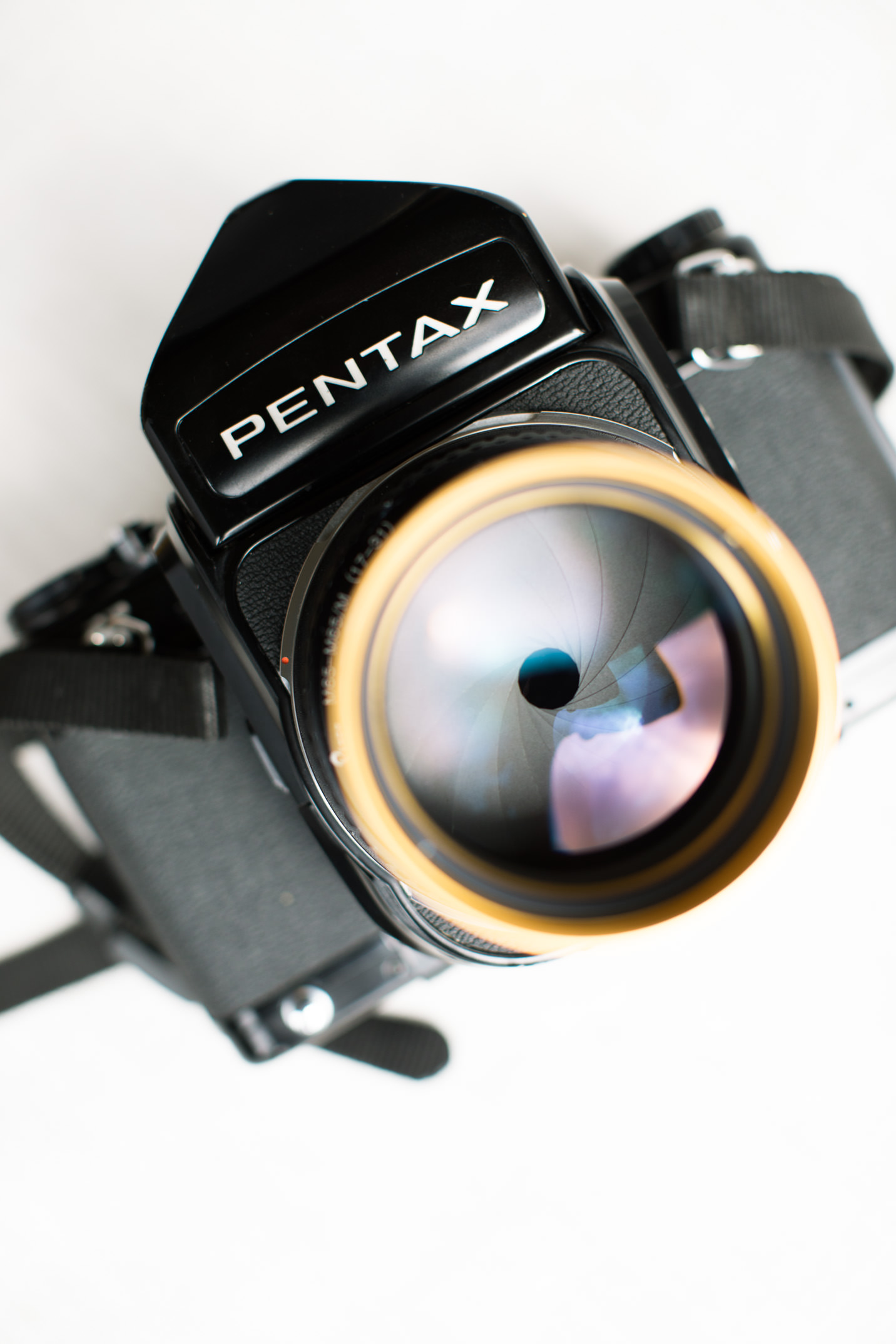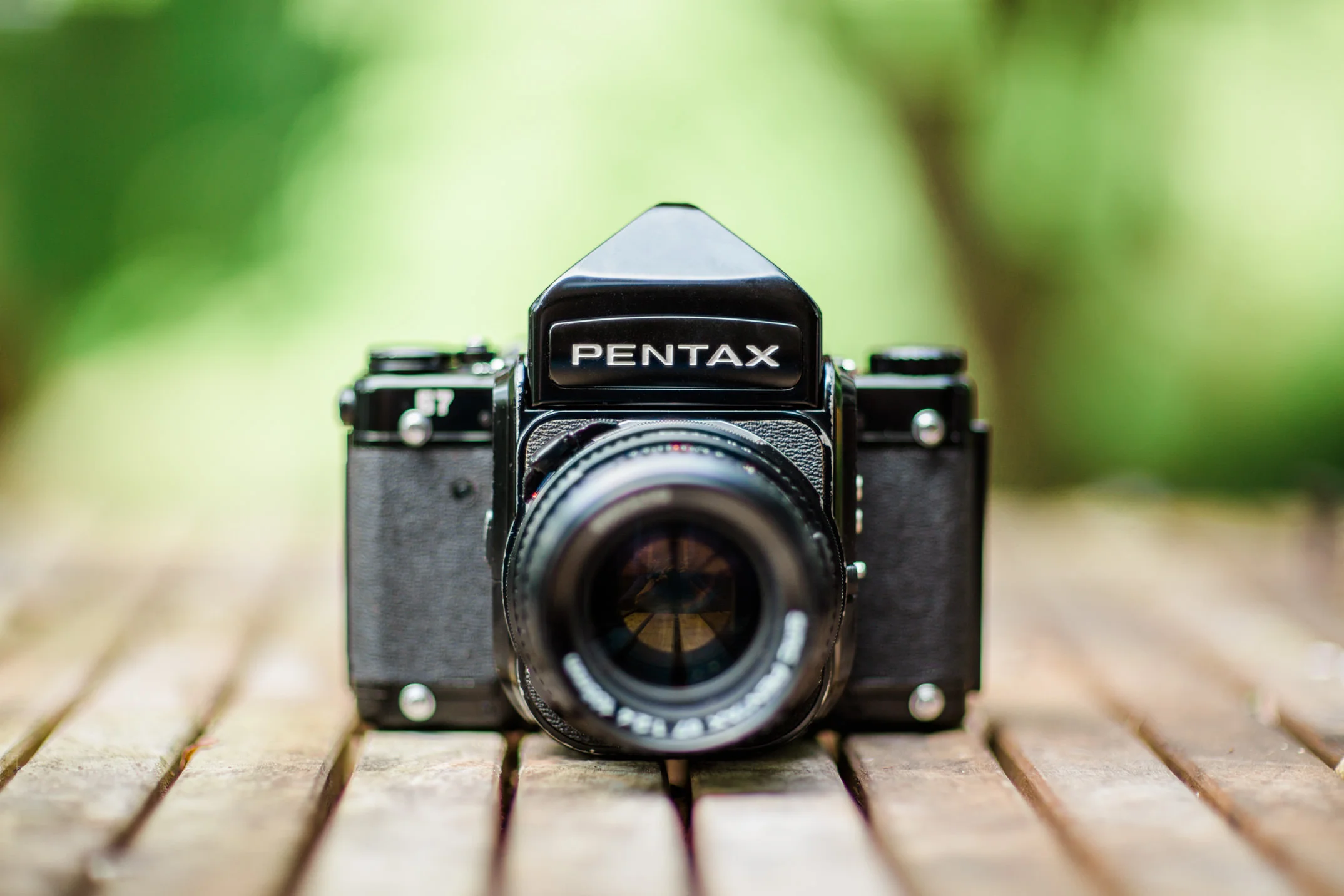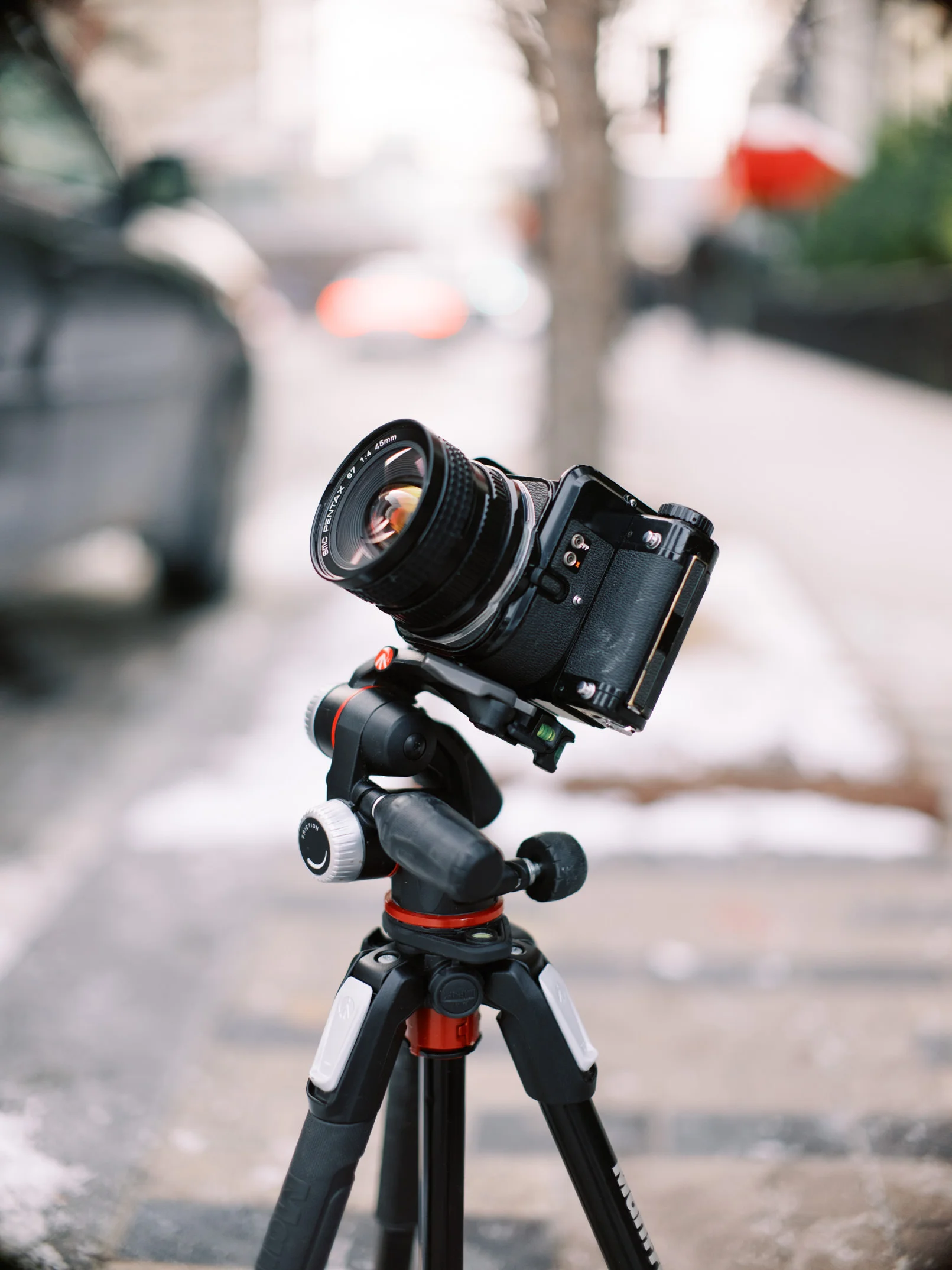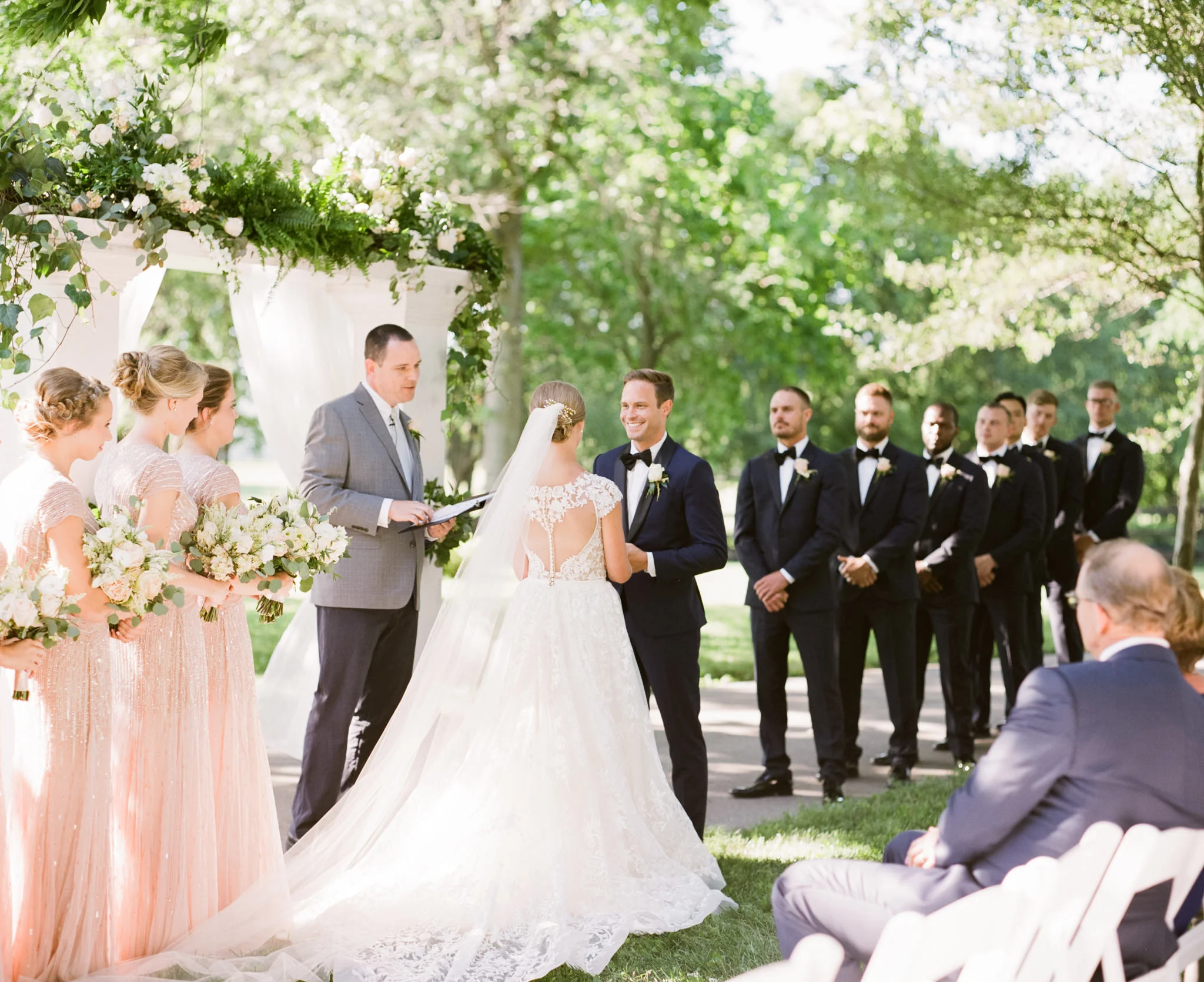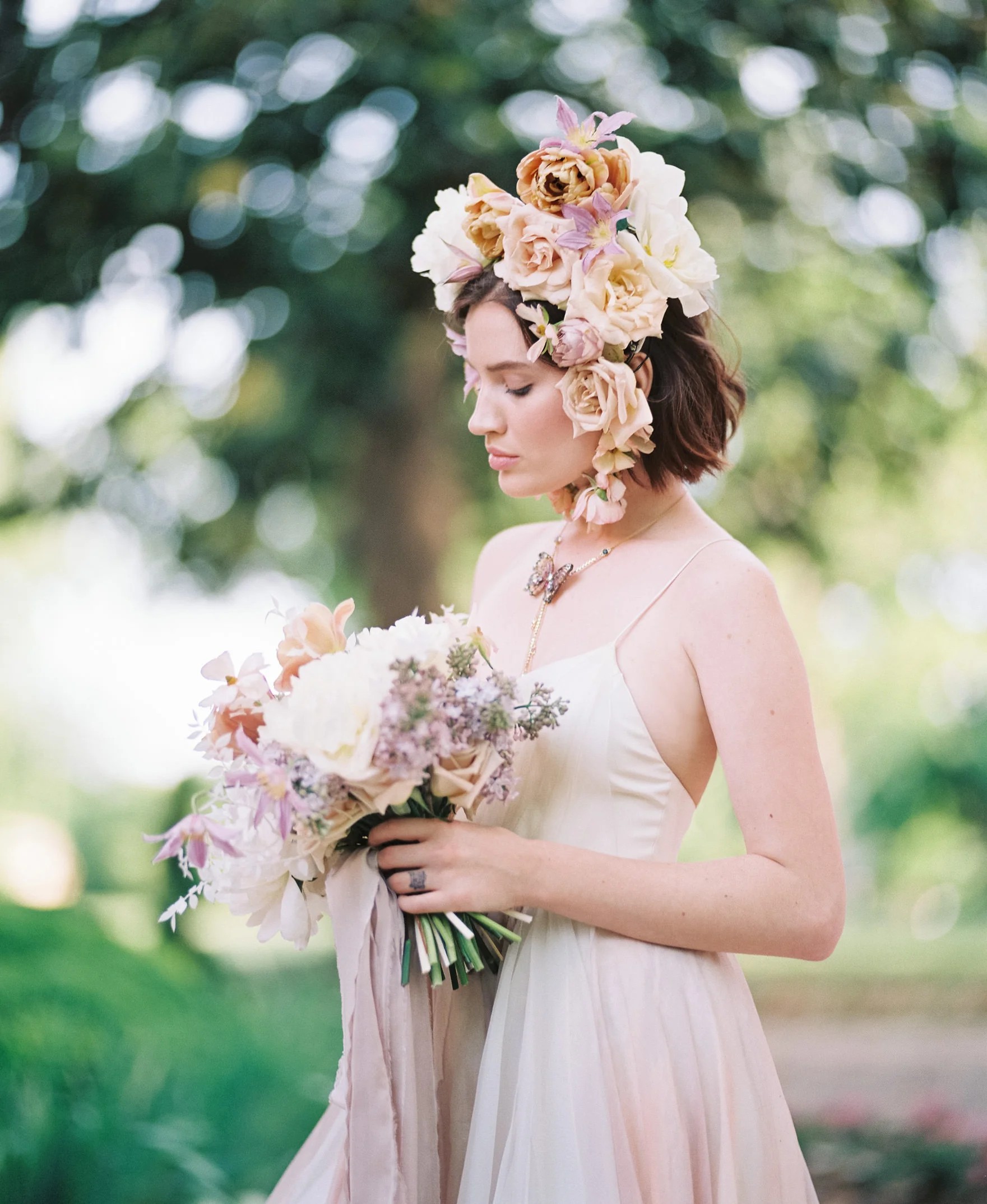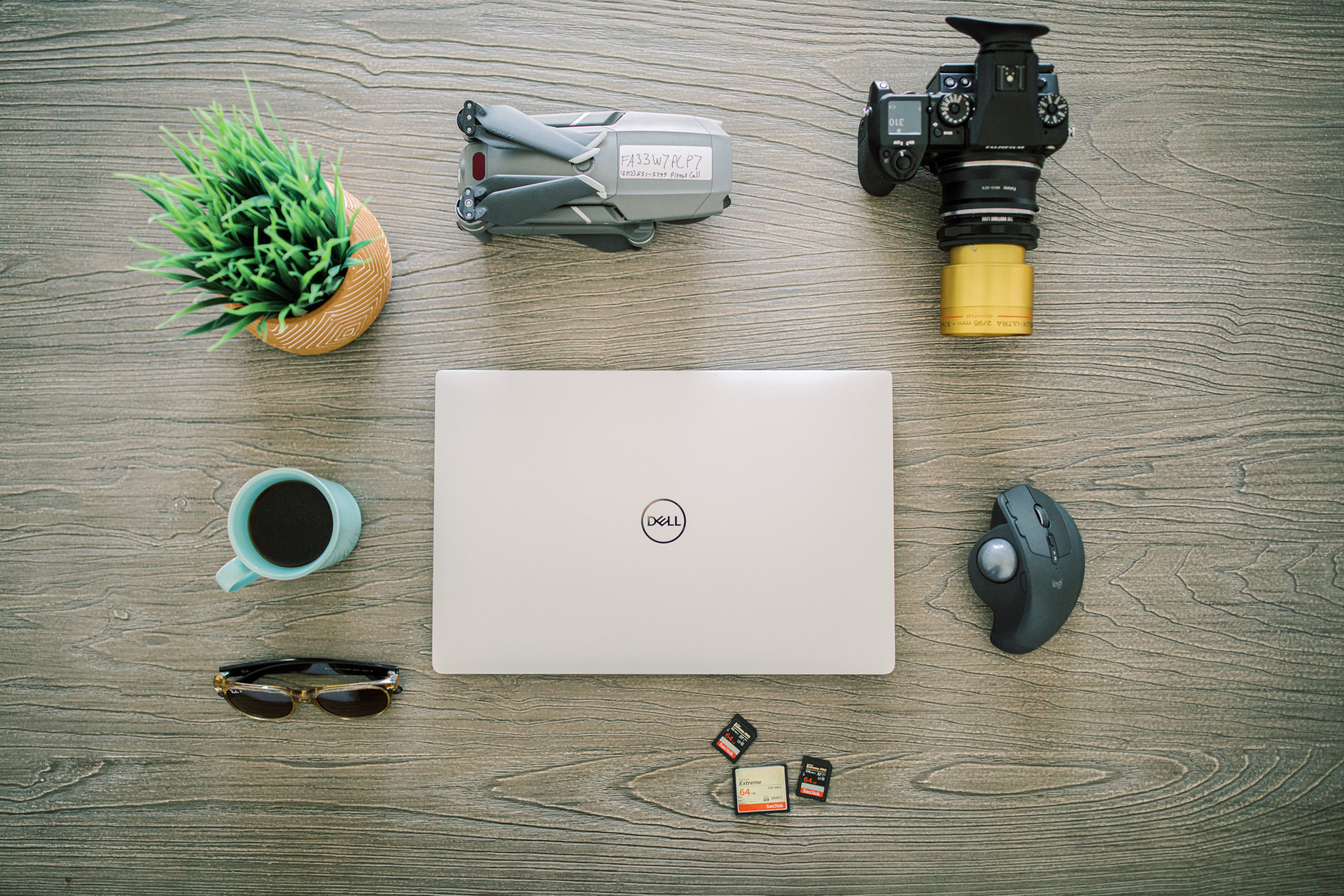Note: This post is part of our "Learn Blog" for photographers. For workshops, coaching, and other resources designed to help grow your skills as a photographer click here (after you read the article, of course)! To be transparent, all links are paid advertising, as a portion of any purchase made while using these links is credited to us. Please, consider using our links to help support what we do! Thank you!
Ah, the Pentax 67—infamous, mighty, and oft accused “Beast”. My review of the Pentax 67 will be a tad different than others, I believe. I’ve shot weddings with this thing (without an assistant) and won’t argue for it being “large”, “beastly”, or heavy. In fact, I don’t think it’s that much heavier or less dynamic than the Pentax 645, which I also regularly use.
To start, I would like to explain that this Pentax 67 review will really be a review of all Pentax 67 versions besides the Pentax 67ii. So, that means this is also a Pentax 6x7 review!
Pentax 67 Review: Why I Bought a Pentax 67
The big reasons I first started looking into a Pentax 67 were as follows:
Easy to focus
Shallow depth of field
Varying Lens Selection
Aspect ratio (5:4)
Large negative for high quality scans
It’s really not THAT big!
ease of focus
When I first (re)began shooting film, I purchased a Canon 1V 35mm film camera (which is great camera to use your EF lenses on), and a Pentax 645 (original) with the Pentax 645 75mm f/2.8 FA lens. While these were great cameras that got me some great results from shooting film stocks like Fuji 400H, Ektar 100, Portra 400, and Portra 800. I found that the hit to miss rate of focus was pretty poor.
Image taken with Pentax 67 using ISCO 110mm Ultra MC from The Boutique Lens
I would consistently KNOW that the frame was in focus in the viewfinder, only to be met with frame after frame out of focus. I tried adjusting my diopter and even bought a focus magnifier, only to continue to be met with out of focus shots.
Now, I don’t mean to paint a nasty picture of the Pentax 645 and 1V. They’re actually great cameras, subject to you getting a good copy (which I believe mine may have had some issues).
In my Pentax 645 review, I will actually tell a redemption story about my Pentax 645nii which I found to be highly accurate, so I’m NOT saying the Pentax 645 is a totally bad choice. But, without the frustrations that several Pentax 645s brought me, I wouldn’t have found the delight that is shooting the Pentax 67.
And worth mentioning, I’ve never had a problem with unexplainable, missed focus on any of the Pentax 67s I’ve owned (which is four).
It was those frustrations with focus from other film cameras, along with a desire for more shallow depth of field for portraits that first led me from 35mm and 645 to the Pentax 67. More on depth of field in the next section!
So, how does the Pentax 67 help with focus? —By the sheer size of the focus screen size. The Pentax 67 focusing is by no means a “bright” screen, but it’s big and makes it pretty easy to see what’s in focus and what’s not.
For more info on the various focusing screens available for Pentax 67 and a discussion about Pentax 67 vs Pentax 67ii focusing screens, view my article on Pentax 67 Focusing Screen Comparison.
Shallow depth of field
As you may know, the larger your negative/sensor, the shallower your depth of field (as long as your focal length and f/stop remains consistent, e.g. a 105mm f/2 lens on Pentax 67 would equal the 35mm/full frame cropped to 4:5 equivalent of about a 45mm f/1.0, or uncropped a 45mm measured horizontally, 52mm vertically, and 50 diagonally f/1.2).
That being said, the Pentax 67 offers the ability to achieve very shallow depth of field. That, coupled with the attractive 5:4 ratio leads your eye and mind to perceive a lot of depth. More on ratio further below!
Varying Lens Selection
The Pentax 67 has a range of native lens options which accommodate f/2.4 (like the 105mm f/2.4). Plus, there are an array of Cinelux lenses that allow you to achieve f/2. Talk about shallow depth of field!
For wider options, I prefer the highly practical Pentax 67 75mm f/2.8 AL, which I reviewed, and the 45mm and 55mm f/4 lenses.
Check out my Pentax 75mm 2.8 AL review here.
Pentax 67 Aspect Ratio
Aspect ratio is the particular crop of any given photograph; it’s the dimension of the horizontal in relation to the vertical length of your frame.
Particularly for portrait orientation, I am not the biggest fan of a 2:3 ratio, which is the typical aspect ratio of a 35mm or full frame camera. It’s just so long vertically while leading your mind to almost feel like the sides are missing.
I much prefer a 4:3 (like a GFX or 645 film camera) or a 5:4 such as the Pentax 67. They present well both in portrait and landscape orientation by creating a sense of “fullness” and depth that you would typically lose with a 2:3 ratio.
Also on the side of 5:4 aspect ratio, it fits perfectly with Instagram’s crop, which happens to be 5:4! So, no need to sacrifice part of your frame and compromise your images when posting to Instagram.
All in all, the 5:4 ratio of the Pentax 67 is not only highly versatile but also very pleasant to the viewer.
large negaTives for high quality
This one is pretty self-explanatory—the larger the negative, generally speaking, the better the resolution. So, Pentax 67 frames come packed with a lot of quality. A 6x7 frame is around 4.3 times the surface area of a 35mm frame and about 1.6 times larger than a 645 film negative (with 645 being 2.7 times larger than 35mm film).
Click here for more info on various film negative sizes and comparisons.
A 6x7 negative is going to give you much less noticeable grain, more ability to zoom/crop in, and possibly better represented sharpness. So, if you’re looking for higher quality images and better print quality, then the large 6x7 negative is highly viable.
it’s really not That big
So, if you’ve read other Pentax 67 reviews, you’ve probably seen it referenced as being “huge”. Let’s put this into perspective—it is huge compared to a Canon G7X, or a point-and-shoot, or even a modern day DSLR.
But, if you’re shooting medium format, at least 645, then a Pentax 67 is really not that much bigger. For perspective, a Pentax 645 weighs 1310g, while the Pentax 67 weighs 1750g. That’s a 440g difference, just shy of a pound difference (15.5 oz.). Is 1 lb. really that big of a difference?
To put things even more into perspective, consider that 4x5 cameras and 8x10 cameras can be significantly more bulky and heavy. In the grand scheme of things, a Pentax 67 is really not THAT big.
Pentax 67 Alternatives | Other 6x7 Film Cameras
The Pentax 67 stands out among other Pentax 67 in that it is very tough, durable, cheap, a versatile in lens choices. However, there are a few other 6x7 cameras which are great for their own reasons.
Mamiya 7 vs Pentax 67
The first on my list is the Mamiya 7. It’s more portable than the Pentax 67. It’s also a rangefinder, which I love. But, it’s also very expensive and doesn’t have any lenses with an aperture wider than f/4. So, it’s great for travel.
Plaubel Makina vs Pentax 67
Also similar to the Mamiya 7 is the fixed lens Plaubel Makina 6x7 film camera featuring a 80mm f/2.8 lens. This is another great 6x7 option, but it lacks the versatility of having interchangeable lenses.
Mamiya RB67 vs Pentax 67
Another popular option is the Mamiya RB67. This option features a rotating back which allows you to shoot either portrait or landscape orientation, all with only rotating the film back. This is great if you shoot with a waist level finder, or if just want the ease of always being able to hold the camera level instead of switching back and forth to achieve portrait/landscape.
The RB67 is a fairly cheap option with lots of pros. I personally never chose it over the Pentax 67 because I like the rendering of the Pentax lenses better. It also weighs about 2000g vs the 1750g of the Pentax 67.
Pentax 67ii vs Pentax 67
The 67ii is more expensive, and is known to have circuit board issues that can render your entire body dead, indefinitely. The redeeming qualities of the 67ii are the native focusing screen which is miles better than the Pentax 67s and the ability to do double exposures.
If you’re interested in learning more of my thoughts about the Pentax 67 vs Pentax 67ii, be sure to check out my article about Pentax 67 version differences which discusses the Pentax 67 compared to the 67ii.
Film Cameras
The Pentax 67 stands out among other Pentax 67 in that it is very tough, durable, cheap, a versatile in lens choices. However, there are a few other 6x7 cameras which are great for their own reasons.
Mamiya 7 vs Pentax 67
The first on my list is the Mamiya 7. It’s more portable than the Pentax 67. It’s also a rangefinder, which I love. But, it’s also very expensive and doesn’t have any lenses with an aperture wider than f/4. So, it’s great for travel.
Plaubel Makina vs Pentax 67
Also similar to the Mamiya 7 is the fixed lens Plaubel Makina 6x7 film camera featuring a 80mm f/2.8 lens. This is another great 6x7 option, but it lacks the versatility of having interchangeable lenses.
Mamiya RB67 vs Pentax 67
Another popular option is the Mamiya RB67. This option features a rotating back which allows you to shoot either portrait or landscape orientation, all with only rotating the film back. This is great if you shoot with a waist level finder, or if just want the ease of always being able to hold the camera level instead of switching back and forth to achieve portrait/landscape.
The RB67 is a fairly cheap option with lots of pros. I personally never chose it over the Pentax 67 because I like the rendering of the Pentax lenses better. It also weighs about 2000g vs the 1750g of the Pentax 67.
Pentax 67ii vs Pentax 67
The 67ii is more expensive, and is known to have circuit board issues that can render your entire body dead, indefinitely. The redeeming qualities of the 67ii are the native focusing screen
Pentax 67 Alternatives | Other 6x7 Film Cameras
The Pentax 67 stands out among other Pentax 67 in that it is very tough, durable, cheap, a versatile in lens choices. However, there are a few other 6x7 cameras which are great for their own reasons.
Mamiya 7 vs Pentax 67
The first on my list is the Mamiya 7. It’s more portable than the Pentax 67. It’s also a rangefinder, which I love. But, it’s also very expensive and doesn’t have any lenses with an aperture wider than f/4. So, it’s great for travel.
Plaubel Makina vs Pentax 67
Also similar to the Mamiya 7 is the fixed lens Plaubel Makina 6x7 film camera featuring a 80mm f/2.8 lens. This is another great 6x7 option, but it lacks the versatility of having interchangeable lenses.
Mamiya RB67 vs Pentax 67
Another popular option is the Mamiya RB67. This option features a rotating back which allows you to shoot either portrait or landscape orientation, all with only rotating the film back. This is great if you shoot with a waist level finder, or if just want the ease of always being able to hold the camera level instead of switching back and forth to achieve portrait/landscape.
The RB67 is a fairly cheap option with lots of pros. I personally never chose it over the Pentax 67 because I like the rendering of the Pentax lenses better. It also weighs about 2000g vs the 1750g of the Pentax 67.
Pentax 67ii vs Pentax 67
The 67ii is more expensive, and is known to have circuit board issues that can render your entire body dead, indefinitely. The redeeming qualities of the 67ii are the native focusing screen which is miles better than the Pentax 67s and the ability to do double exposures.
If you’re interested in learning more of my thoughts about the Pentax 67 vs Pentax 67ii, be sure to check out my article about Pentax 67 version differences which discusses the Pentax 67 compared to the 67ii.
Where to Buy a Pentax 67
I personally recommend buying Pentax 67s off eBay. It’s always good to make sure that you choose a seller with great reviews and a good return policy.
I bought my first Pentax 6x7 from a person on Facebook. It was described as in excellent working order with a recent CLA. However, within the first few weeks, it developed a film advance issue that caused the first and second frame to overlap.
Had I bought it from eBay, I would have had the option to do a return.
Cost of Pentax 67s + Pentax 67 Accessories
Pentax 67s are pretty cheap with most bodies running around $350-600. 6x7s without MLU (mirror lock-up) tend to be cheaper with 6x7 with MLU being mid-range, and then the Pentax 67 being generally a little higher. To learn more about MLU, other Pentax 67 version differences, and other accessories for the Pentax 67, be sure to check out my article on Pentax 67 version differences.
Pentax 67 Review Conclusion
The Pentax 67 is not one of my favorite cameras by accident. Offering ease of focus, ability to create very shallow depth of field for artistic uses, a highly versatile aspect ration, and large negatives for quality, all in a portable package, the Pentax 67 system simply amazing.
Let us know your thoughts in the comments below!
If you’re considering purchasing a Pentax 67, please consider supporting us by using our eBay link!

